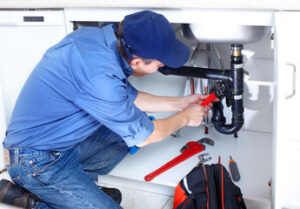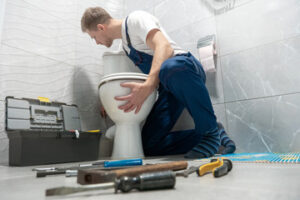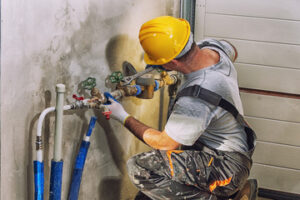Your Ranger Plumbing Company logo is the first thing your clients see when evaluating you as a professional. A strong plumbing brand signals that you take your business seriously and separates you from amateur plumbers.

The Plumbing Industry is embracing a new wave of innovation with the advancement of robotic technologies. Those who embrace these technologies will be able to offer their clients cutting-edge solutions and peace of mind.
Branding is a process of shaping how your clients perceive you, and it includes everything from the logos you use to the colors you choose. It’s important to make sure your branding is on-trend and aligned with your client’s expectations, so you can stand out from the competition.
The first step in establishing your brand is choosing the right business structure. There are several options, including sole proprietorship, limited liability company, and corporation. A sole proprietorship is the easiest to set up but doesn’t provide any protection for your personal assets. An LLC or corporation is more complex to establish, but offers robust liability protection and flexible tax options. Having the correct business structure in place will allow you to grow your business and build trust with clients.
Once you’ve chosen the best business structure for your plumbing company, it’s time to create a logo and brand identity. A logo is a visual representation of your brand, and it communicates to potential customers how you’ll solve their problems. It’s also a great way to convey your values and personality. A well-designed logo is clean, memorable, and aesthetically pleasing.
Before you begin designing your plumbing company logo, decide what type of impression you want to leave with your audience. Your logo should evoke a sense of trust, professionalism, and quality. Choose a color that is relevant to your industry, and keep in mind that your logo should reflect your personality and the services you offer.
A catchy slogan can help you attract and engage your target audience, and it should be easy to remember. It’s important to align your slogan with your values and tone, so it reflects the message your plumbing company is trying to convey.
Your marketing materials, from your equipment trucks to your website and social media profiles, should all feature your plumbing company’s logo and contact information. This consistency will help you establish a strong brand presence and foster customer loyalty.
Another way to promote your plumbing business is by participating in local community events. This is a great way to build your network and gain visibility in your area. Additionally, you can use customer referral programs to generate new leads. This is a great way to get the word out about your plumbing business, and it will show that you care about your clients.
Logo Design
When homeowners are in need of a plumber, they often make a snap decision about who to call based on their experience with previous service providers and what they see online or at home. If you want your plumbing business to stand out, a well-designed logo is essential. A professional logo communicates your expertise and trustworthiness to potential clients. It also helps you distinguish yourself from amateur contractors.
Plumbing company logos should have a clean design to ensure that they are readable when reproduced in different media. They should also be scalable and have enough blank space to prevent them from becoming blurry when printed on paper, on a banner, or on the side of your work vehicle. This will help you avoid paying for costly reprints and save money in the long run.
Another important aspect of plumbing logo design is color. Choosing a color that evokes the right emotion is crucial to establishing brand identity and promoting your services. You can also use color to convey your business’s personality and tone of voice, or simply show how you want prospects to feel when they interact with your brand.
Logos should also be designed with typography in mind. It is one of the most important elements in a logo, as it can communicate your brand’s personality and tone of voice without using images or graphics. You can choose between many types of fonts to express your business’s message, and the way that they are arranged can convey certain emotions, such as trustworthiness or strength.
It is also important to avoid using stock images in your plumbing logo. These images are likely to be used by other companies, which could lead to legal problems in the future. Instead, it is better to find a designer that offers custom images to ensure that you are protected from this issue.
A plumbing contractor’s logo is a key piece of their marketing strategy, and it needs to be designed with a lot of care. A poor-quality logo can make your plumbing business look bad and cost you customers. Investing in a professional graphic design agency can help you avoid these mistakes and get the best results out of your marketing dollars.
Website Design
An attractive and professional website is essential for showcasing your plumbing services and gaining clients’ trust. A clean, intuitive layout and easy-to-understand content make for a compelling user experience that keeps visitors on your site. A mobile-friendly website also makes it easier for users to browse your services and contact information on the go.
A strong online presence is also important for establishing credibility and boosting your SEO. A quality website with positive reviews and testimonials can make a difference when it comes to turning potential customers into loyal customers. A comprehensive online portfolio can also showcase your plumbing expertise and build brand awareness.
Optimizing your site for search engines is another important aspect of website design for plumbing professionals. The use of tools like Wix SEO and other free or paid search engine optimization platforms can help you discover optimal keywords, improve your content, and get more traffic to your website.
Whether you’re looking to start a new plumbing business or need to update your existing website, Weblium offers an intuitive tool that lets you create a stylish and customizable plumber’s website in minutes. You can choose a template that matches your plumbing company’s identity, and the intuitive editor allows you to change colors and fonts to suit your aesthetic preferences. You can even upload your logo and service offerings, add customer reviews, and display a gallery of projects to boost your reputation.
To set yourself apart from competitors, clearly communicate your unique selling points on your plumbing company’s website. This could include highlighting the fact that you offer 24/7 availability or having years of experience. Visual elements, such as videos featuring before-and-after transformations or a walkthrough of your service process, can be especially impactful.
Clear calls-to-action (CTAs) are also key to converting casual browsers into paying clients. Whether you’re encouraging people to request a free quote, join your mailing list for monthly plumbing tips, or call for immediate assistance, these CTAs should be prominently displayed and worded in a way that’s designed to inspire action. Adding these CTAs to your homepage, service pages, and blog posts can significantly boost user engagement and conversions.
Marketing
When establishing a plumbing company, marketing strategies are vital for attracting new customers and maintaining a loyal client base. These strategies can include developing a strong brand identity, creating an attractive website, and using social media to boost visibility and build trust. Moreover, these strategies should focus on ensuring that the message your company sends is consistent with your goals and values.
The plumbing market is highly competitive, so it’s essential to have a solid marketing plan in place. A good plan should include a clear definition of your target audience and what they expect from your services. This will help you craft more targeted advertising and ensure that your messages align with their needs.
It is also important to understand your target audience’s demographics. For example, if your target audience is comprised of busy homeowners, you may want to emphasize convenience and time-saving in your messaging. A plumbing company that specializes in luxury services, on the other hand, will likely focus on service quality and aesthetics.
Another essential metric for plumbing companies is the customer lifetime value (CLTV). This metric measures the average amount of money a customer will spend with your business over their entire relationship with it. This metric is critical for assessing the success of your marketing strategy and determining how much to invest in future advertising campaigns.
One of the best ways to reach potential customers is by promoting your plumbing company locally. By participating in community events, sponsoring local teams, and making social contacts with your neighbors, you can increase your brand’s visibility and build a positive reputation. In addition, many consumers are willing to pay more for services and products from businesses that demonstrate a commitment to social responsibility.
Incorporating video marketing into your plumbing company marketing strategy is an effective way to reach a wider audience and nurture leads. Whether it’s a DIY “how-to” video or an engaging Q&A live session with your clients, videos are an excellent tool for conveying your plumbing company’s expertise and building trust. Adding QR codes to your business cards and flyers is an additional way to promote your plumbing company and encourage on-the-go customers to engage with your brand.

